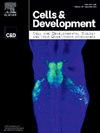Nuclear localization and transactivation of SYS-1/β-catenin is the result of serial gene duplications and subfunctionalizations
IF 3.9
4区 生物学
Q4 Biochemistry, Genetics and Molecular Biology
引用次数: 0
Abstract
β-catenin is a highly conserved multifunctional protein capable of mediating cell adhesion via E-cadherin and transactivation of target genes of the canonical Wnt signaling pathway. The nematode, C. elegans contains four paralogs of β-catenin which are highly specific in their functions. Though similar in overall structure, the four beta-catenins are functionally distinct, each regulating different aspects of development. Of the four, SYS-1 is a key player in Wnt dependent asymmetric cell division (ACD). In ACD, a polarized mother will give rise to a daughter with high nuclear SYS-1 and another with low nuclear SYS-1. Despite sequence dissimilarity, SYS-1 shares a close structural resemblance with human β-catenin where it retains an unstructured amino-terminus (NTD) and 12 armadillo repeats. Using existing genome sequence data from several nematode species, we find that the four β-catenin paralogs result from 3 sequential gene duplications and neofunctionalizations during nematode evolution. SYS-1, however, lacks an unstructured carboxyl-terminus (CTD) that is essential for human β-catenin transactivation processes. This work supports the hypothesis that SYS-1 compensated for the lack of CTD by acquiring novel transactivation domains with cryptic nuclear localization signals in the NTD and the first four armadillo repeats, as shown by transactivation assays in worms and yeast. Furthermore, SYS-1 regulatory domains are not localized to the NTD as in canonical β-catenin and instead spans the entire length of the protein. Truncating SYS-1 abolishes the classical SYS-1 nuclear asymmetry, resulting in daughter cells with symmetrical SYS-1 truncation localization. A screen for SYS-1 physical interactors followed by in vivo SYS-1 localization analyses and effects on cell fate suggest that proper SYS-1 nuclear export is facilitated by XPO-1, while an interaction with IMB-3, an importin β-like protein, suggests import mechanisms. Interestingly, XPO-1 is especially required for lowering SYS-1 in the Wnt-unsignaled nucleus, suggesting a distinct mechanism for regulating asymmetric nuclear SYS-1. In summary, we provide insights on the mechanism of β-catenin evolution within nematodes and inform SYS-1 transactivation and nuclear transport mechanisms.
SYS-1/β-catenin的核定位和转激活是一系列基因复制和亚功能化的结果。
β-catenin是一种高度保守的多功能蛋白,能够通过E-cadherin介导细胞粘附和典型Wnt信号通路靶基因的转激活。秀丽隐杆线虫含有四种β-连环蛋白,它们在功能上具有高度特异性。虽然整体结构相似,但这四种β -连环蛋白在功能上是不同的,各自调节发育的不同方面。其中,SYS-1在Wnt依赖性非对称细胞分裂(ACD)中起关键作用。在ACD中,极化的母亲会生出高核SYS-1的女儿和低核SYS-1的女儿。尽管序列不同,但系统-1在结构上与人类β-catenin非常相似,它保留了一个非结构化氨基末端(NTD)和12个犰狳重复序列。利用现有的几种线虫的基因组序列数据,我们发现4种β-catenin同源物是线虫进化过程中3次序列基因复制和新功能化的结果。然而,SYS-1缺乏对人类β-catenin转激活过程至关重要的非结构化羧基端(CTD)。这项工作支持了一种假设,即SYS-1通过在NTD和前四个犰狳重复序列中获得具有隐性核定位信号的新转激活结构域来补偿CTD的缺乏,正如在蠕虫和酵母中的转激活实验所显示的那样。此外,SYS-1调节结构域不像典型β-catenin那样局限于NTD,而是跨越整个蛋白质的长度。截断SYS-1消除了经典的SYS-1核不对称性,导致子细胞具有对称的SYS-1截断定位。对SYS-1物理相互作用物的筛选、体内SYS-1定位分析和对细胞命运的影响表明,XPO-1促进了SYS-1核输出,而与IMB-3(一种输入蛋白β样蛋白)的相互作用表明了输入机制。有趣的是,XPO-1对于降低wnt未信号核中的SYS-1是特别需要的,这表明不对称核SYS-1的调节有独特的机制。综上所述,我们对线虫内β-catenin的进化机制有了深入的了解,并为SYS-1的转激活和核转运机制提供了信息。
本文章由计算机程序翻译,如有差异,请以英文原文为准。
求助全文
约1分钟内获得全文
求助全文
来源期刊

Cells and Development
Biochemistry, Genetics and Molecular Biology-Developmental Biology
CiteScore
2.90
自引率
0.00%
发文量
33
审稿时长
41 days
 求助内容:
求助内容: 应助结果提醒方式:
应助结果提醒方式:


